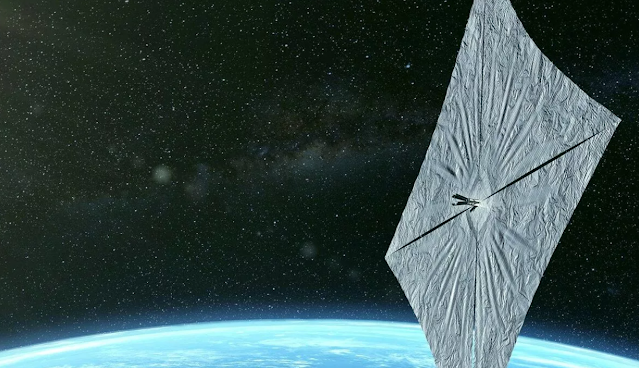As NASA's exploration continues to push the envelope, the agency has chosen a novel solar sail design for development into a demonstration mission that might transport research to new locations.
The NASA Innovative Advanced Concepts (NIAC) program has chosen the Diffractive Solar Sailing project for Phase III investigation. Phase III attempts to deliberately convert NIAC concepts that have the most promise for NASA, other government agencies, or private partners.
“As we venture farther out into the cosmos than ever before, we’ll need innovative, cutting-edge technologies to drive our missions,” NASA Administrator Bill Nelson said. “The NASA Innovative Advanced Concepts program helps to unlock visionary ideas – like novel solar sails – and bring them closer to reality.”
Solar sails use the pressure generated by sunlight to move a vehicle across space, just way a sailboat uses the wind to span the ocean. Existing reflecting solar sail designs are often huge and thin, and they are constrained by the direction of the sun, necessitating power and navigation choices.
Small gratings embedded in thin films would be used in diffractive lightsails to take advantage of diffraction, a feature of light that causes light to spread out as it passes through a tiny hole. This would allow the spaceship to utilise sunlight more efficiently while maintaining agility.
“Exploring the universe means we need new instruments, new ideas, and new ways of going places,” said Jim Reuter, associate administrator for NASA's Space Technology Mission Directorate (STMD) in Washington. “Our goal is to invest in those technologies throughout their lifecycle to support a robust ecosystem of innovation.”
The new NIAC Phase III funding will provide the research team with $2 million over two years to pursue technology development in anticipation of a possible future demonstration mission. Amber Dubill of the Johns Hopkins University Applied Physics Laboratory in Laurel, Maryland, is the project's leader.
“NIAC allows us to foster some of the most creative technology concepts in aerospace,” stated Mike LaPointe, acting program executive for NASA Headquarters' NIAC program. “Our goal is to change the possible, and diffractive solar sailing promises to do just that for a number of exciting new mission applications.”
Diffractive lightsailing would expand the capabilities of solar sails beyond what is now achievable with missions under development. Amber Dubill of the Johns Hopkins University Applied Physics Laboratory in Laurel, Maryland, is leading the study. Dr. Grover Swartzlander of Rochester Institute of Technology in New York, who remains as a co-investigator on the project, led prior feasibility studies under NIAC's Phase I and Phase II contracts. Les Johnson, the project manager for two of NASA's future solar sail missions based at the Marshall Space Flight Center in Huntsville, Alabama, is also a co-investigator. The team conceived, manufactured, and tested several types of diffractive sail materials, performed tests, and devised novel navigation and control techniques for a prospective diffractive lightsail mission orbiting the Sun's poles as part of previous grants.
In support of this proposed solar mission, Phase III work will improve the sail material and conduct ground testing. Using traditional spacecraft propulsion, orbits traveling over the Sun's north and south poles are difficult to achieve. Lightweight diffractive lightsails powered by sunlight's steady pressure might orbit the Sun's poles, advancing our understanding of the Sun and improving our space weather forecasting skills.
“Diffractive solar sailing is a modern take on the decades-old vision of lightsails. While this technology can improve a multitude of mission architectures, it is poised to highly impact the heliophysics community’s need for unique solar observation capabilities,”according to Dubill. “With our team’s combined expertise in optics, aerospace, traditional solar sailing, and metamaterials, we hope to allow scientists to see the Sun as never before.”
